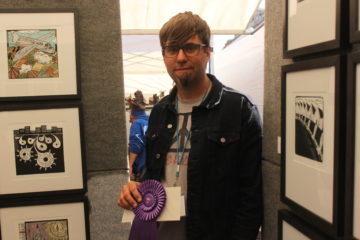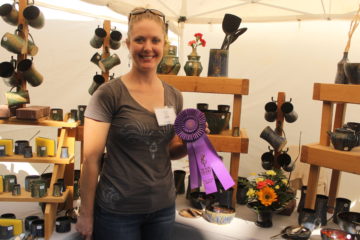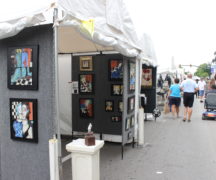By DAVID DUPONT
BG Independent News
Neil Kemarly didn’t think anyone would really want to buy the woodwork he created.
His wife had other ideas.
So together they started traveling the art fair circuit, where Kemarly, from Pioneer, found out people were willing to pay for his benches and cabinetry.
The judges at those art fairs also recognized their worth.
Kemarly was awarded best of show, $1,600, at the 25th Black Swamp Arts Festival Saturday. In 2015, he won the best 3D award at the festival.
Kemarly continues to take his work on the road despite losing his wife, partner, and ‘best friend” to cancer in April, 2016. “This is my therapy,” he said.
The shows judges Kathy Buszkiewicz and Brandon Briggs said as they made their rounds separately, they independently determined Kemarly’s work was a winner.
Buszkiewicz said they she was impressed the way that Kemarly was able to work the imperfections in the wood and the way he corrected them, into the overall design.
Briggs said the work was a testament to the beauty of simplicity.
Kemarly said he pursues woodwork as a contrast to his day job as a tool and die maker. Working in his shop wood when he decides to cut a plank, he doesn’t have an engineer telling him he can’t.
“I see myself as a builder and a maker.”
Other art show award winners were:
- Chris Plummer, printmaking, first place 2D, $1,100.
- Rachel Stevens Morgan, ceramics, first place, 3D, $1,100.
- Samuel Hitchman, ceramics, second place, $850.
- Paula Gill, fiber, third place, $600.
- Derrick Riley, printmaking, Rick Braveheart, photography, and Dave Thompson, mixed media, all honorable mention, each $200.
All the award winners are automatically given a place in next year’s show.
Plummer’s award added to a long list of honors at the show, including best of show honors in 2013 and 2015.

Chris Plummer
His prints must constantly be evolving in order to continue that kind of success. He experiments with new ways of printing, and expands his subject matter. Lately, he said, he’s made prints with more political content.
The Kentucky artist also said that his work has also been influenced by his work teaching art to elementary school children in his kids’ school a few times a month.
He was trying to figure out how to teach printmaking when he hit upon a method using molded plastic and a pencil. He liked the technique so much, he used it himself to make prints, several of which were on sale in his booth.
It allows him to experiment since he can create a print in four hours rather than the four weeks it take for a woodcut print.
He also finds the free thinking of the youngest kids to be inspiring. “The younger ones don’t even think about it,” he said. “They just make it.”
Plummer pointed to a print of a wild angel floating above a landscape as one of his own work that was inspired by a first grader’s response to an assignment to create a Christmas card.
Briggs said while at previous shows he’s been drawn to Plummer’s more colorful work this year what caught his attention was his black and white woodcuts with their suburban scenes of neighborhoods, parking lots and roadways.

Rachel Stevens Morgan
Ceramics represented a change in course for 3D winner Stevens. She was a biology major at Western Carolina University when a friend convinced her to take a community college ceramics course.
She loved it, especially working in three dimensions, and ended up switching her major. Her parents, she said, were supportive of this shift.
Her mother, Lori Jones, who was working in the booth agreed. “I love watching her doing what she loves and making a living at it.”
Morgan quipped that she enjoyed having her mother’s free help in the booth.
Morgan joined the art fair circuit because “it was away I could instantly start making money.”
Making a living meant doing as many as 30 shows a year.
Showing her pots at art fairs, Morgan said, has led to her placing her work in galleries. The resident of the Asheville, North Carolina area, said she’s cut back to about 20 shows a year.
Buszkiewicz said Morgan distinguished herself by her use of color, and her delicate touch in handling the clay. “It was “very, very light and beautifully done.”
Briggs said this was another case where “you just know” at first glance the work is special.





